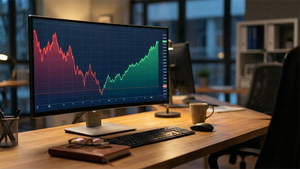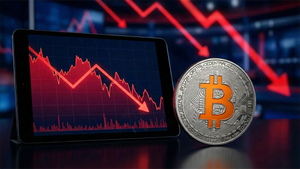Investors are Bracing Up For The Worse Losses To Come From The Tech Stock Market
It’s been almost a decade since large tech stocks have had their worst decline in a decade or more. Fearful of another dot-com crisis, some investors are expecting even worse losses in the future.
Since 2002, the S&P 500’s information technology sector has had its worst start to a year in more than a decade. After a 13 percent drop since 2004, the S&P 500 now has the biggest gap between it and the rest of the market. According to Morningstar Direct data dating back to 1993, investors have withdrawn a record $7.6 billion this year from technology-focused mutual and exchange-traded funds.
Stocks of technology firms have been driving the market upward for years, propelling key indices to historic highs. As a result of the fervor around everything from cloud computing to software and social media, stock prices shot through the roof. At the beginning of the Covid-19 epidemic, the Federal Reserve’s accommodating policies encouraged a seemingly endless thirst for risky investments.
In contrast to last year, this year’s investors confront a very different landscape. Since the beginning of 2018, treasury rates have risen to their highest level since then, while bond prices have plummeted. Trends such as optimistic options trading, special-purpose acquisition firms, and cryptocurrencies have all taken a dramatic turn for the worst in the last two years. The S&P 500’s only gainers are those in the energy and utility sectors.
Tech’s lengthy reign of market domination may be coming to an end, say some investors. Resurgent shares of businesses like Exxon Mobil, Coca-Cola, and Altria Group Inc. have been welcomed by value investors who like to purchase stocks that are undervalued based on metrics like profits or book value.
In its biggest margin since 2000, the S&P 500 Value index is beating the S&P 500 Growth index, which includes Tesla Inc., Nvidia Corp., and Meta Platforms Inc. According to data provider EPFR, investors have put more than $13 billion into funds monitoring value equities, while more than $48 billion has been withdrawn from funds tracking growth stocks.
Chris Covington, head of investments at AJO Vista, described the shift as “essentially a change in market regime.” The extraordinary outperformance of growth that you have seen in the previous five years would be hard for me to accept.”
Market instability and betting against technology have many investors thinking about the dot-com bubble of 2000 when investors, large and small lost money on speculative bets on soon-to-go-bankrupt firms. A combination of cheap interest rates and the attraction of technical advancement drove a rush to invest in internet firms.
In only a few hours, hundreds of billions of dollars in market value were wiped out from the IT sector’s worth. During a single trading session in late May, Snap Inc. shares dropped by 43 percent, marking the company’s worst one-day decrease in percentage terms and a loss of about $16 billion in market value. Affirm Holdings Inc. and Coinbase Global Inc. have lost more than half of their value in 2022, despite being formerly highfliers.
The industry’s most powerful players have been hit hard. This year, the S&P 500 has seen a greater decrease in the popular FAANG stocks—Facebook parent Meta Platforms Inc., Amazon.com Inc., Apple Inc., Netflix Inc., and Google parent Alphabet Inc.—than the losses in the FAANGs.
Many investors are guessing about what sector of the market will see the next decline after the traumatic start to the year.
One of the co-head of asset allocation at Boston money manager GMO Ben Inker noted that when bubbles burke, they tend not just to collapse to their fair value, but they also tend to go the other way.
For more than a year, Mr. Inker has been betting against growth firms with high valuations. He says this additional premium for growth stocks over value equities is more than ever before.
Bank of America analysts said on May 27 that even after the selloff, technology companies still make up a near-record 27% of the broad S&P 500 index, hanging around the highest levels since the dot-com boom. In several of the stocks, the business warned that it was too early to acquire the dildos.
Although there may be some similarities, there are also significant distinctions between today’s market and that of the dot-com crash. Despite the current rise in tech company values, the S&P 500’s forward multiples have not yet reached the 26.2 levels seen in March 2000.
While Treasury rates have increased recently, they are still significantly below historical levels. The 10-year Treasury’s yield is now at 3%. In the year 2000, the percentage was about 5%.
The Federal Reserve’s rate-hiking cycle is still in its infancy. Interest rates are expected to rise at a steady pace throughout the year. As a result, rates are expected to rise in the near future, placing pressure on high-growth companies like technology. Companies’ future cash flows become less appealing as rates rise.
Rates must fall in order for the stock market to recover, according to Mr. Inker, if rates rise further. “Really, it all comes down to where interest rates end up,” said one economist.
Despite recent data showing otherwise, fears of an impending recession have been fanned by the Federal Reserve’s intentions to raise interest rates.
In recent months, several investors have sold their negative holdings in technology equities. In the second quarter, S3 Partners predicts that short interest in the S&P 500’s IT sector will fall by the greatest, but it will still be the most shorted sector. Tesla, Apple, Microsoft, and Amazon are among the most shorted businesses, as they were in the previous two years.
There are still some investors and experts who believe that tech’s reign of supremacy is far from finished.
Analyst Jay Kaeppel of Sundial Capital Research thinks the worst may be over for the technology sector because of an increased put-to-call option ratio on the Technology Select Sector SPDR Fund (XLK).
David Eiswert, a portfolio manager at T.Rowe Price, remarked, “We learned that things simply don’t move straight up.” Forget about buying merely a bunch of tech stocks and hoping for the best. It’s imperative that you distinguish between the two.” Some tech companies, such as Amazon, seem to be appealing after recent drops, according to Mr. Eiswert.
The post Investors are Bracing Up For The Worse Losses To Come From The Tech Stock Market appeared first on Best Stocks.
More News
View More




Recent Quotes
View MoreQuotes delayed at least 20 minutes.
By accessing this page, you agree to the Privacy Policy and Terms Of Service.